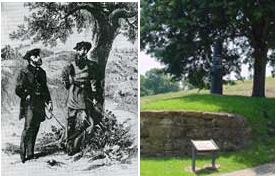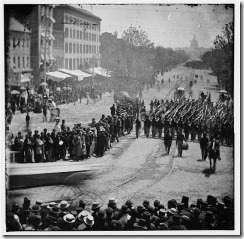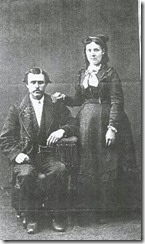Anson Croman and the 150th Anniversary of the Grand Review
May 22, 2015 § Leave a comment
On May 23, 1865, the Army of the Potomac, which including the 20th Michigan Infantry Regiment, paraded in the Grand Review of the Armies in Washington D.C. The Army of the Potomac had defeated the Army of Northern Virginia forcing General Lee to surrender.
”Washington, D.C. Infantry unit with fixed bayonets followed by ambulances passing on Pennsylvania Avenue near the Treasury” – Library of Congress caption.
Click for larger image.
None of the units are identified in the Library of Congress’s photos of the Grand Review. While this may not be the 20th Michigan, this illustrates how the 20th Michigan appeared at the Grand Review.
Library of Congress states: No known restrictions on publication (Library of Congress)
The next day on May 24th, the Army of the Tennessee paraded. Under the command of General Sherman, they had defeated the Confederate armies south and west of Virginia, forcing their surrender in North Carolina shortly after General Lee’s surrender.
This was a bittersweet celebration. The Confederacy was defeated and the major rebel armies had surrendered. But Abraham Lincoln, the architect of the victory with the abolition of slavery and reunification, was not present as he had been murdered five weeks earlier.
After the Grand Review, Anson Croman and the 20th Michigan were demobilized and returned to Michigan. Anson married Mariah.
Anson and Mariah Croman, undated.
Among the many things he did was with the rest of his life was to care for his great-grandchildren including my mother-in-law Marge (Mitchell) Robinson.
One of Anson’s great-grandsons Robert remembers Anson calling to his great-grandchildren to “come shake the hand that shook Abe Lincoln’s!”.
Anson died two months before his 94th birthday in 1938 and is buried in Mt. Hope Cemetery in Waterloo, Michigan.
2004 photo of Anson Croman gravestone by Ralph E. Robinson, Anson’s great-grandson-in-law.
Links, sources, and more information:
1865: Anson Croman and the Civil War
1865 – 1938: The Rest of His Life
The Library of Congress has over 134 photos of the Grand Review.
If Anson Croman wrote letters home, none have survived.
Therefore the best way to preserve the story of his service is by sharing the history of his regiment.
Records document that Anson Croman was with his regiment from his 1862 enlistment until the Confederate surrender at Appomattox, Virginia in 1865.
The Musbachs and Robinsons are direct line descendants of Anson Croman and he is my 2nd great-grandfather-in-law.
Shortlink: http://wp.me/p5YuOj-1S
Anson Croman and the 20th Michigan in the Appomattox Campaign 150 Years Ago
April 9, 2015 § 1 Comment

Orange ellipse, lower right: Location of the 20th Michigan at Sutherland Station, Virginia in a support position for the troops that pursued and trapped Lee’s army at Appomattox. Click on map for larger image.
Public domain image from the United States Military Academy (West Point) History Department’s American Civil War Atlas
150 years ago over the night of April 2-3, 1865 Robert E. Lee and the Army of Northern Virginia retreated from Richmond to link up with General Johnson’s Army of Tennessee just to south in North Carolina.
Pursuing Union troops blocked every road south so Lee’s army was forced to retreat to the west.
The IXth Corps which included the 20th Michigan supported the pursuit by protecting the Union’s southern flank. The IXth Corps was also quickly repairing the South Side Railroad to supply the pursuing troops by rail.
Anson Croman and the 20th Michigan Infantry Regiment were in a support position at the Sutherland Station southwest of Richmond and west of Petersburg.
On April 9, the Union trapped General Lee at Appomattox finally forcing him to surrender to General Grant.
That is considered the symbolic end of the Civil War.
The last of the Confederate forces west of the Mississippi River surrendered in June marking the actual end of the Civil War.
Why Lee May Not Have Surrendered Earlier
After President Lincoln’s reelection in November, 1864, any hope of winning Confederate independence through war or negotiations ended.
Several times earlier in the war, Confederate generals surrendered without their troops being completely trapped and on the verge of total destruction as were General Lee’s forces at Appomattox.
As did those other Confederate generals, General Lee had the authority and opportunity to surrender.
University of Virginia historian Elizabeth R. Varnon suggests that General Lee knew independence was no longer possible and slavery was over.
Professor Varnon’s analysis is that General Lee held out as long as he did in order to place the Southern aristocracy in the strongest position possible to preserve as many of their privileges as possible including in race relations.
Links, sources, and more information:
 Appomattox: Victory, Defeat, and Freedom at the End of the Civil War by Elizabeth R. Varon
Appomattox: Victory, Defeat, and Freedom at the End of the Civil War by Elizabeth R. Varon
1865: Anson Croman and the Civil War
If Anson Croman wrote letters home, none have survived. Therefore the best way to preserve the story of his service is by sharing the history of his regiment
Records document that Anson Croman was with his regiment from his 1862 enlistment until the Confederate surrender at Appomattox, Virginia in 1865.
The Musbachs and Robinsons are direct line descendants of Anson Croman and he is my 2nd great-grandfather-in-law.
Shortlink: http://wp.me/p5YuOj-1w
150 Years Ago the 20th Michigan Enters Petersburg
April 3, 2015 § 1 Comment
By the end of March, 1865, Union and Confederate forces faced each others along 37 miles of trenches from north of Richmond to southwest of Petersburg.
The Confederates had suffered major losses in an unsuccessful attempt to break out and escape followed by an unsuccessful effort to prevent the Union forces from outflanking those trenches about eight miles southwest of Petersburg.
The few Confederates remaining in the trenches hungry and at their breaking point.
On April 2, 1865, the Union attacked seeking a breakthrough at a weak point. the IXth Corps attacked from their positions just south of the Appomattox River and east of Petersburg. Anson Croman and the 20th Michigan Infantry Regiment were in the IXth Corps. They were position north of the attack ready to provide support.
The IXth Corps captured the Confederate Fort Mahone but was blocked by the Confederates from advancing further.
However, other Union units broke through at several places to the south and west forcing the Confederates to evacuate and retreat from both Petersburg and Richmond. The next day April 3, 1865, the Union army entered Petersburg.
The 20th Michigan was the third unit to raise its flag over the Petersburg courthouse.
Meanwhile, Abraham Lincoln, who was nearby at Grant’s headquarters at City Point, Virginia, toured the battlefield.
Links, sources, and more information:
1865: Anson Croman and the Civil War
If Anson Croman wrote letters home, none have survived. Therefore the best way to preserve the story of his service is by sharing the history of his regiment
Records document that Anson Croman was with his regiment from his 1862 enlistment until the Confederate surrender at Appomattox, Virginia in 1865.
The Musbachs and Robinsons are direct line descendants of Anson Croman and he is my 2nd great-grandfather-in-law.
Shortlink: http://wp.me/p5YuOj-1c
Anson Croman and the 150th Anniversary of the Battle of Fort Stedman
March 30, 2015 § Leave a comment
Cizewski, Lovetere, Musbach, & Robinson Families
Orange arrow pointing to circle, upper center: March 23, 1865 position of the 20th Michigan at Battery Number 9 just north of Fort Stedman two days before the battle.
Click on image for larger version.
Original base map in the public domain with additions by The Siege of Petersburg Online
Since June, 1864, General Grant had been extending the Union siege lines southwest of Petersburg and north of Richmond. That had stretched the Confederate forces to the breaking point.
In January, 1865 the Union had captured Wilmington, North Carolina and closed the last major Confederate port. That cut off more of the few supplies that were still making it around the Union siege lines.
Robert E. Lee realized the Union siege of Petersburg and Richmond was about to result in the capture of both cities and his army.
He decided to launch an attack on the eastern end of the…
View original post 141 more words
70 and 150 Years Ago: Two Promotions
January 30, 2015 § Leave a comment
Cizewski, Lovetere, Musbach, & Robinson Families
70 years ago on January 1, 1945, Felix A. Cizewski, was promoted to Private First Class.
He was serving in Company C, 3110th Signal Service Battalion, Army Service Forces in Paris. He was in a hospital recovering from frostbite.
He is my late father.
LEFT: Private Felix A. Cizewski on
occupation duty in Munich between
April and July, 1945.
From the collection of Felix A. Cizewski
© Leonard H. Cizewski
RIGHT: Unit Morning Report recording
his promotion.
Public domain image
150 years ago on January 26, 1865, Anson Croman was promoted to corporal.
He served in Company F, 20th Michigan Infantry Regiment, Second Brigade, First Division, IX Corps, Army of the Potomac. At that time the 20th Michigan was part of the Union siege of Petersburg near Battery Nine just south of the the Appomattox River on the northeast edge of the city.
Anson Croman is Cheryl A. Robinson’s 2nd great-grandfather…
View original post 41 more words
Anson Croman 150 Years Ago: August to December, 1864
December 30, 2014 § Leave a comment
Cizewski, Lovetere, Musbach, & Robinson Families
150 years ago Anson Croman and the 20th Michigan Infantry Regiment continued to serve in the Siege of Petersburg Virginia, south of Richmond.
By August, 1864 they could only muster about 85 men for duty. When the 20th Michigan began service in July, 1862 it had 1012 enlisted men and officers.
After the defeats in June and July, 1864, General Grant ceased frontal assaults on the Confederate defenses of Petersburg.
Instead he sought ways to cut off the railroads supplying Richmond and Petersburg and force the Confederates to extend their lines to the breaking point.
The IX Corps with the 20th Michigan were part of that campaign including:
August 19 to 21: The Weldon Railroad south of Petersburg connected the besieged Confederates with their last major port of Wilmington, North Carolina.
After a series of battles, the Union captured a section of the Weldon Railroad.
That forced the Confederates to…
View original post 423 more words
150th anniversary of the 20th Michigan in the Battle of the Crater
July 30, 2014 § Leave a comment
Cizewski, Lovetere, Musbach, & Robinson Families
By June 12, 1864 the Confederates stopped the Union forces outside of Petersburg, Virginia. The Union ceased assaulting Petersburg and switched to a siege.
In an attempt to break into Petersburg, IXth Corps Union troops with coal mining experience dug a tunnel to place a mine under Confederate fortifications just east of Petersburg.
One hundred fifty years ago on July 30, 1864 the mine was exploded and Union troops assaulted Confederate positions. Among them was our Civil War ancestor Anson Croman in the 20th Michigan Infantry Regiment.
 20th Michigan’s position (ORANGE CIRCLE) and direction of the attack to the west of the crater from the mine explosion.
20th Michigan’s position (ORANGE CIRCLE) and direction of the attack to the west of the crater from the mine explosion.
Fair use of image from The Battle Atlas of the Civil War © Time-Life Books
 Contemporary drawing of the Union assault on The Crater. The 20th Michigan is to the left out of this picture.
Contemporary drawing of the Union assault on The Crater. The 20th Michigan is to the left out of this picture.
Image in the public domain.
The Confederates held…
View original post 228 more words
150th anniversary of Anson Croman and the 20th Michigan in the 1864 Overland Campaign
June 30, 2014 § Leave a comment
Cizewski, Lovetere, Musbach, & Robinson Families
Public domain image from the National Park Service |
On May 4, 1864, General Grant began the Overland Campaign which would lead 11 months later to the capture of the Confederate capitol of Richmond and the surrender of the main Confederate army in April, 1865.
The Overland Campaign lasted until June 12, 1864.
Anson Croman served in the 20th Michigan, IXth Corps.
Details are at:
Anson Croman and the Civil War: 1864
More information from the National Park Service:
Overland Campaign to Siege: Visitor Guide to Petersburg’s 1864/2014 Sesquicentennial Commemoration
If Anson Croman wrote letters home, none have survived. Therefore the best way to preserve the story of his service is by sharing the history of his regiment
Records document that Anson Croman was with his regiment from his 1862 enlistment until the Confederate surrender at Appomattox, Virginia in 1865.
The Musbachs and Robinsons are direct line descendants of Anson…
View original post 9 more words
150th anniversary of Anson Croman and the 20th Michigan at the 1863 siege & battle of Knoxville
December 1, 2013 § Leave a comment
Cizewski, Lovetere, Musbach, & Robinson Families
In August 1863, after the fall of Vicksburg, Mississippi, the 20th Michigan returned to Kentucky.
In October, the 20th Michigan crossed through the Cumberland Gap to eastern Tennessee.
Many people in eastern Tennessee were strongly pro-Union. One of President Lincoln’s priorities was to secure the area and provide them protection from the Confederates.
In September 1863, after the Confederate victory at Chickamauga, Georgia, the main Union army retreated to Chattanooga, Tennessee. The Confederates cut…
View original post 355 more words
Two anniversaries: the 150th of the Battle of Gettysburg and Siege of Vicksburg
July 4, 2013 § Leave a comment
Cizewski, Lovetere, Musbach, & Robinson Families
 Left: Sketch of Union General Grant discussing Vicksburg’s surrender with Confederate General Pemberton 150 years ago on July 3, 1863.
Left: Sketch of Union General Grant discussing Vicksburg’s surrender with Confederate General Pemberton 150 years ago on July 3, 1863.
Right: Surrender discussion site today.
Public domain images from the National Park Service.
During the observance of the 150th anniversary of the 1863 Battle of Gettysburg the question is again asked: “What if the Confederates had won?”.
Here’s my answer:
The most likely scenario after a Union defeat at Gettysburg is that the Union army retreated intact and in good order to its next planned line of defense at Pipe Creek, Maryland, 12 miles southeast of Gettysburg.
Vicksburg, Mississippi would still surrender on July 4, 1863.
Along with the city and its 30,000 defenders, the Confederacy lost control of the Mississippi River and was split in two. The eastern half was now cut off from desperately needed reinforcements and supplies from the Confederacy west of the Mississippi.
Even with a…
View original post 862 more words











